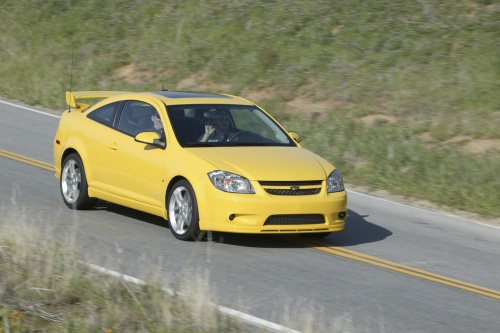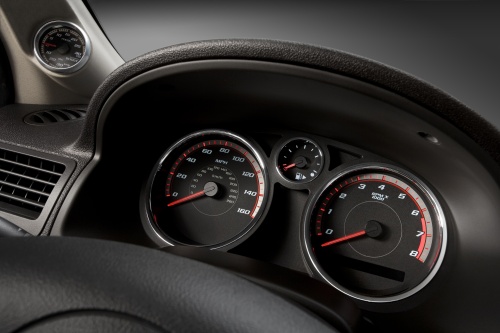
By David Ponce
When GM invited me (disclosure: expenses paid) to California to test the 2008 Cobalt SS, now turbocharged… I half expected a schmaltzy sales pitch and a somewhat spirited drive. And while I got the (not-so-schmaltzy) pitch and the drive, I never, not by a long shot, expected the kind of kick-in-the-pants performance it delivered. If it’s an affordable race car you’re looking for…
This.
Is.
It.
The 2008 Cobalt SS will out pace and outmaneuver just about anything in its class. Civic Si, Golf GTI, watch out. Aside from the turbocharged 260hp Ecotec engine, a combination of two technical features (no-lift shift and launch control) give the car a clear edge in acceleration, while Brembo brakes stop it on a dime and Nürburgring-tuned FE5 Sport suspension keep it on the track. If it wasn’t for a couple of underwhelming aesthetic choices, I’d give this car full marks.
Read on for the full review.

The Event
Drive day started at the dealership, where we were introduced to the new features. I’ll list more at the end of the article, but most notably, the 2008 Cobalt SS features:
2.0L Ecotec turbocharged and intercooled engine with 260 horsepower (194 kW)
Brembo fixed-caliper front discs and vented rear disc brakes
18-inch forged aluminum wheels and Y-rated summer performance tires
30 mpg estimated highway fuel economy
18-inch forged aluminum wheels and Y-rated summer performance tires

That’s all fine and dandy on paper, but on the road, these bullet points come alive. We first took the cars through the streets of Bakersfield, CA. The car is comfortable and unassuming in regular city driving. It’s not loud, and it’s a breeze to drive. But then, we took them into a winding, twisting country road. Middle-of-nowhere-ville. Step-on-it-ville. No-police-around-ville. And they go fast. And they don’t fall off cliffs. And they growl, and grip the road and snap your head and altogether make you feel like sticking your face out the window like an idiot. But this was still public roads, and I didn’t dare floor it.
So far, so good. But we were due for some track time.
Buttonwillow
At Buttonwillow race track, we were introduced to two features that give this car an unmistakable edge over its competitors: launch control and no-lift shift.
Launch Control
Some cars have this, so alone, it’s not that big a deal. It’s basically traction control, but specifically tuned for drag racing. In the Cobalt, it’s implemented as an optional performance setting. You press a button on the dashboard a few times, until the instrument cluster displays “Competitive Mode” (or something like that). Then, when the vehicle is at a standstill, the display will show “Launch Control”. This is your cue to floor it. Really. Step on clutch, put in gear and floor it. The engine will stabilize at 5,100 RPM, waiting for you to let go of the clutch. Let go normally, and the car will launch forward with minimum wheel spin. Should you let go off the clutch too fast, a different algorithm will kick in, preventing wheel hop. Done properly, Launch Control will give you maximum acceleration at launch, consistently. But combine it with No-Lift Shift, and your drag race enters a different ballpark.
No-Lift Shift
This is a unique feature, and one that gives the Cobalt SS a clear advantage in racing conditions. Anyone familiar with turbocharged cars will be aware of the unmistakable sound a turbo makes when shifting gears at high revs. Every time you let go of the gas pedal to shift into a higher gear, the turbo flushes its boost. You then have to rebuild your boost on every successive gear, losing considerable time to turbo lag. The turbo spooling up and down is the sound you hear.
With No-Lift Shift, this loss of pressure is eliminated. The turbo keeps its boost throughout your trek up to 5th gear (provided you shift fast enough, I think within 0.2 seconds). But in order to do this, you have to learn to drive a little differently. Basically, you floor it, and never lift your right foot off the pedal, even as you shift (hence the name). It’s somewhat hard to do, as it goes against the way you’ve likely been driving for years. But this will keep the turbo spinning between gear changes, and will slice 0.07 seconds between every gear change. It may not seem like much, but over longer races, can translate up to a 0.5 second advantage per lap. And combined with launch control, it gives this car an easy, consistent 0-60mph time of 5.7 seconds with virtually no torque steer.
The top speed, by the way, is 160mph. That’s not an artificial limit. That’s as fast as aerodynamics will allow.
The Track
It was time to see how all these features translated into track driving. After all, the Cobalt SS had been fine tuned at Nurburgring, admittedly the best racing track on the planet. Well, I’m no professional driver. But I have one word to say: HolyCow! The FE5 suspension simply sticks it to the road, allowing you to take it up to 0.9g. The 260 horses, along with the 260ft/lb of torque (reached at 2,000 RPM, by the way) launch it out of every corner. The Recaro-style seats keep you in place while you push it, and floor it, and brake it, and try to trash the hell out of it, and yet, it sounds like it wants more.
And as it turns out, it does.
See, I’m no professional driver. But John Heinricy, Director, High Performance Vehicles, might as well be. Matter of fact, he’s won a bunch of SCCA championships, and actually set the world record in the FWD sports compact class at the Nurburgring with this very Cobalt. He ran the 14 miles (22kms) in 8:22.85 minutes, a full 13 seconds better than the previous record. Well, I went for a little ride with him. And while I might have pushed the Cobalt to maybe 60% of what it could do, John shoved it all the way to 95%.
I thought I would die. Maybe the video can show you why. I’ve never seen curves come up to me this fast, with me not ending up in some kind of ditch. The point being that this is a $23,000 car that was handling like a racecar three times its price.
I’m saying it. If you want a car that can kick the ass of just about anything that doesn’t cost upwards of an arm, the 2008 Cobalt SS is the way to go. It’s fast, it’s agile, and better yet, GM wants you to kick the hell out of it. See, even if you take it to the track every single day, and drive it like a maniac, the 5-year, 100,000 mile warranty still holds. As long as you don’t make any unauthorized mods to it, you’re free to floor it, and drag it, and race it until you grow bored of doing so.
The Bad
Well, it’s not all roses and peaches. When it comes to sheer performance, the 2008 Cobalt SS is second to none in its class (I’ve driven the Civic Si, and Golf GTI, by way of comparison). And while its exterior (with the 18-inch alloy wheels, and lowered front fascia) is also really pleasing to the eye, there are a couple of aesthetic elements that could have used a tiny bit more polish. Chief among them is the dash.

For some reason, a somewhat cheap looking silver plastic was used, giving it an awkward look, decidedly unworthy of the rest of the interior (which was quite nice, as you’ll see in the gallery images). Also, the design of the instrument cluster, as well as the standard radio simply didn’t look sharp.

Also, for what can only be construed as a performance/budget-oriented reason, the engine was left uncovered. While that’s very common, some higher end cars have taken to covering the engine in molded plastic. This (while doing absolutely zero to make the car go any faster), will give owners in the target demographic (read: young) the impression that they’re driving a car worth considerably more than $23,000. It’s really all about perception, and little details like that will go a long way. It actually wouldn’t be all that bad if the exposed engine actually looked hot (think colored aftermarket CAI kits, etc.). But it doesn’t. It looks functional, with some pipes and hoses wrapped in what really looks like tinfoil. That tastes of DIY. Yeah, it goes fast and it gets the job done. But I think I’d keep the hood down.
The Conclusion
Aesthetic considerations aside, the 2008 Chevrolet Cobalt SS is a true race car. Never in my life did I expect such performance. Such grip. Such speed. It was a pleasure to drive, a pleasure to race and a pleasure to drag. If you’re serious about leaving your “opponents” in the dust, this isn’t such a bad idea. Especially since it looks somewhat unassuming. And at $22,995 MSRP, you’re unlikely to find a better bang for the buck.
PROS:
• Engineered and developed by GM Performance Division
• 2.0L Ecotec turbocharged and intercooled engine with 260 horsepower (194 kW)
• 30 mpg estimated highway fuel economy
• Nürburgring-tuned FE5 Sport suspension delivers 0.9 g grip
• Brembo fixed-caliper front discs and vented rear disc brakes
• SS-specific appearance with unique fascias and rear spoiler – including available high wing
• 18-inch forged aluminum wheels and Y-rated summer performance tires
• SS-specific interior with new sport seats, A-pillar boost gauge and more
CONS:
• Unappealing dash, with silver plastic finish.
• Unappealing engine bay, with tinfoil-wrapped hoses and pipes.
The Gallery
Everyone loves pictures, so enjoy.




























